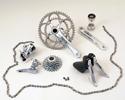
Recently on Cyclingnews.com |
Quick Spins – December 27, 2007Edited by James Huang Got Tech? Send press releases, news, and tech questions to the Cyclingnews tech-heads. Welcome to Quick Spins, an all new section within Cyclingnews' tech coverage were we put some of the smaller items that land on the tech desk to the test.
The modern lightweight carbon fiber and aluminum parts of today's high-performance machines virtually require the use of a precision torque wrench these days, but many versions are either too costly or unwieldly for most home mechanics. Former Vittoria/Geax designer and product manager Alberto De Gioannini breaks down the cost and convenience barrier with the first product to come out of his new Effetto Mariposa brand name, the Giustaforza torque wrench. At just 165mm (6.5") long, the Giustaforza is nearly identical in size to a typical cigar yet boasts a versatile 2-16Nm range. There is no foot-pound scale, but that's no big deal since all bicycle specifications we've come across are in SI units, anyway. The high quality construction utilizes machined-and-anodized aluminum with laser-etched markings and graduations, and both the body and adjusting knob on the tool's end are deeply knurled for a positive grip. The magnetic head accepts any of the wide array of included bits (2, 2.5, 3, 4, 5, 6, and 8mm Allen, a long 5mm hex, T20 and T25 Torx, two flathead, and three Philips head), and the whole package commands a reasonable cost of US$175. None of this would be worth squat if the Giustaforza wasn't accurate, and we're pleased to report that it is within a scant 0.5Nm of a far more expensive digital model from Snap-On and easier to use to boot. So let's recap here: small, neatly designed, accurate, reasonably priced… hell, the thing even looks good, as one would expect of something designed and made in Italy. Gripes? Nothing of any real significance that we can think of, and it's not often that we can say that. /JH Price: US$175 PhotographyFor a thumbnail gallery of these images, click here Images by James Huang/Cyclingnews.com
SRAM Rival group - the performance of Force at a fraction of the priceMuch has been written about SRAM's Force debut into the premium road component group category, and for good reason. It works superbly, boasts excellent ergonomics, is competitively lightweight, and has managed to present a viable third alternative in a highly competitive and evolved market. Yet with all the fanfare, its lesser Rival group has seemingly gone sadly unnoticed. Rival is nearly 40% less expensive than Force, yet is only about 100g heavier. More importantly, the two groups are essentially identical in terms of function: shifter internals, lever ergonomics, and nearly all of the aluminum forgings are shared between them. Heck, even the chain and cassette use the same part numbers. Most of the changes relate only to materials, as Force employs more liberal use of more exotic carbon fiber, titanium, and magnesium bits in an effort to bring its weight down. We took a slightly different take on this evaluation and put our Rival group on a 'cross bike, where the typically harsher environment would be more likely to highlight any deficiencies. The only omissions from the complete package were in the braking category, where we obviously substituted a set of cantilevers, and we also swapped out the 53T outer ring on our standard crankset for a more 'cross-friendly 48T model from Salsa. Several months on dirt and tarmac did not disappoint and we were quickly reminded here just how good so called 'mid-level' stuff has gotten. The overall performance and feel of Rival so closely mimics Force that we would have a hard time distinguishing the two with our eyes shut. Shift quality front and rear is just as snappy and positive, the levers work just as well with cantilevers as they do with road calipers, and SRAM thankfully also offers Rival in both standard and compact versions. Ok, let's see: 99% of Force capability at 60% of its price with about a 100g weight penalty. Um… right. What are we missing here? If we had to focus on anything, Rival's biggest shortcoming as compared to Force is its crankset, whose solid forged aluminum construction makes up about 60g of that 100g figure on its own. Potential Rival owners would do themselves a favor by going with the optional Rival OCT version with its more advanced hollow-forged aluminum arms. They save a relatively minor 24g, but their fully enclosed cross-section is almost certainly more rigid than the standard version's open 'C'-shaped one. In our opinion, they look decidedly more upscale, too. Otherwise, since Rival is a near carbon copy of Force, it also shares some of its deficiencies. We still think the brake lever is just a tad too short, some users will probably lament the passing of the big ring trim function (although in fairness to SRAM, it isn't necessary when the drivetrain is set up properly), and bearing friction in the GXP bottom bracket is still only passable at best. The latest Red group handily addresses all of those issues with a few key changes, but SRAM is still mum on whether those updates will trickle down to later versions of Rival and Force. We've already inquired as to whether or not the Red shifter spools will retrofit into the Rival and Force bodies (thus earning the Zero Loss travel feature and the big ring trim) and the official answer was 'no'. Minor quirks and all, Rival still represents an extraordinary value in the mid-level market. Unless you can't bear to have anything but the best, this will more than suffice for just about anyone looking for top-level performance. /JH
Price: US$345 (DoubleTap levers); US$105 (rear derailleur);
US$57 (front derailleur); US$158 (crankset with bottom bracket);
US$200 (OCT crankset with bottom bracket); US$97 (OG 1070 cassette);
US$33 (PC 1070 chain); US$991 (complete Rival group with standard
crankset) PhotographyFor a thumbnail gallery of these images, click here Images by James Huang/Cyclingnews.com
|







